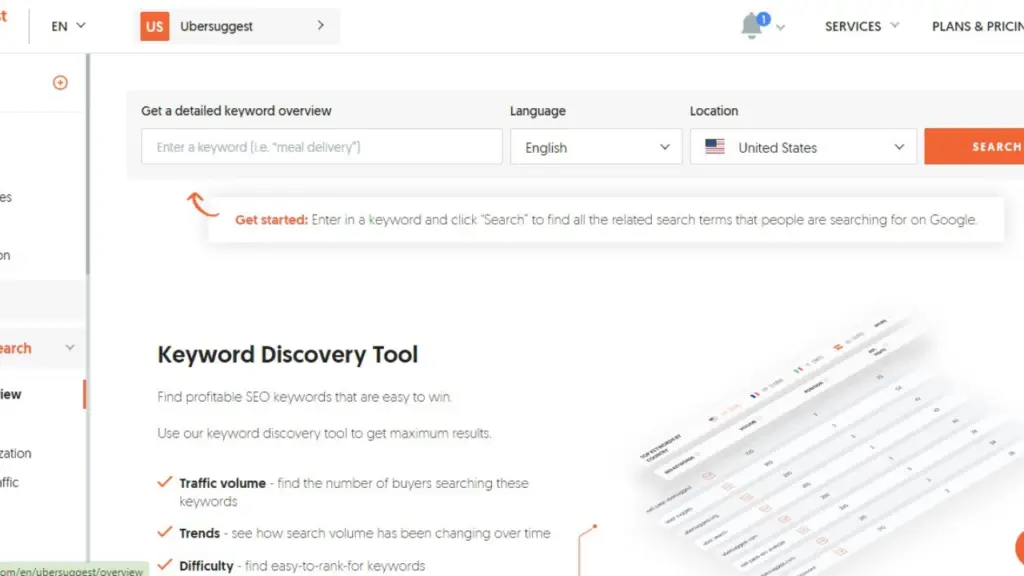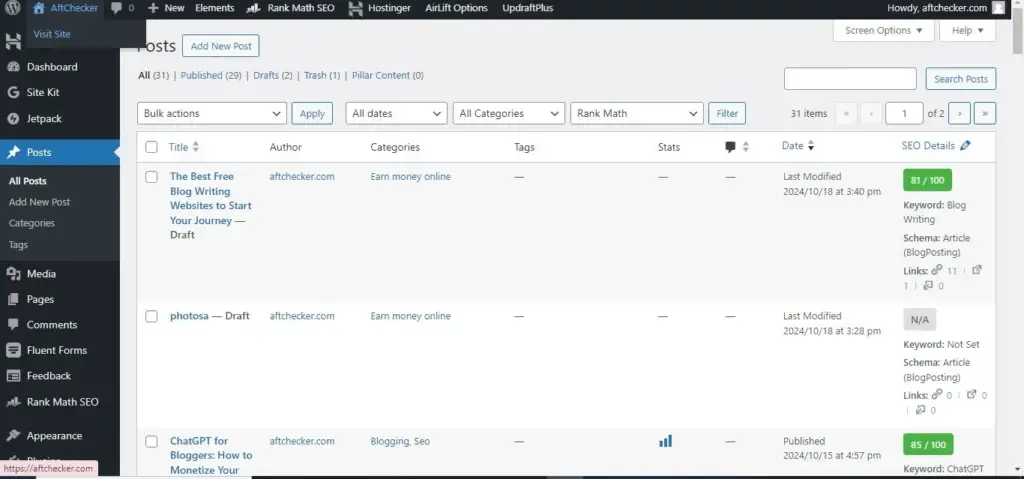Learn SEO basics for beginners! Discover how to optimize your site, choose keywords, and improve your Google rankings effectively.
1. Introduction to SEO: What is SEO and Why is it Important?
Search engine optimization, commonly known as SEO, is a technique used to optimize your website for search engine tools such as Google, Bing, Yahoo, and other platforms. The main purpose of SEO is to ensure that when a user searches for topics or products related to your website or blog, it appears in the search results. Effectively structuring the content and layout of your website makes it attractive to search engines. SEO is an important component of online marketing because it drives organic, or unpaid, traffic to your website, helping you generate more leads and sales.
SEO is important because of its ability to make your website accessible to consumers and search engines. While paid advertising can yield immediate results, SEO focuses on long-term success. It’s important to ensure your content is relevant to what users are looking for and that your website is easy for search engine crawlers to understand. By properly optimizing your website for SEO, your site’s chances of appearing on the first page of search results significantly increase when someone searches for something related to your business or blog.
Ranking high on Google is very important because most websites don’t make it past the first page. Studies show that the top results on Google get the most clicks, while links at the bottom attract the least attention. When your website ranks high, users perceive it as more trustworthy and reliable, making them more likely to click through to your site. It not only drives traffic but also increases the credibility and authority of your brand. That’s why investing in SEO is critical to making your website stand out in a crowded online market.
2. Understanding How Google Search Works
Google search is a complex process based on crawling, indexing, and ranking. First, Google web crawlers, also known as spiders, use it to scan billions of web pages on the Internet. These crawlers follow links from page to page and collect content from all over the place. When you’re done collecting data, Google lets you store the pages in its extensive index. This index is like a massive library in which everything is organized so that when a user asks a question, Google can quickly find the relevant information.
The ranking process is very important for SEO. Whenever a user searches for something on Google, the search algorithms analyze the indexed pages and see which pages match the queries we ask the most. Algorithms take into account many factors, such as keyword relevance, website structure, mobile friendliness, and quality of backlinks. It then ranks the pages and sees the most relevant and authoritative results at the top. Ranking criteria that match a website well, look higher in Google’s search results, which is the primary goal of SEO.

Search algorithms play a very important role in SEO, as they are constantly evolving so that users can get the best possible results. As Google’s algorithms become more sophisticated, they are better able to understand user intent and deliver results that match what logs are searching for. This means that SEO practices must also be kept current with updates. Nowadays, Google values user experience and content quality, which is changing the way websites are optimized. Therefore, understanding algorithms is essential if you want to improve your website’s visibility and SEO success.
3. Keyword Research: The Foundation of SEO
Keyword research is the backbone of SEO strategy. This helps you understand what your target audience is looking for so you can create content that meets their needs and interests. If your keywords aren’t right, your content is unlikely to reach your intended audience. Targeting the right search terms can increase your website’s visibility on search engines, such as Google, which can improve your rankings.
Several tools can make keyword research easier. Tools like Google Keyword Planner and Ubersuggest are great options. These tools provide insight into search volume, keyword difficulty, and relevant keywords. Not only do they help you find keywords, but they also inform you of the competition for each keyword, allowing you to focus on the terms that you rank best for. Can help give By analyzing data with these tools, you can create content that resonates with your audience.

Additionally, websites like Aft Checker offer keyword research tools that can further refine your strategy. In Aft Checker, you can search for keywords, evaluate their performance, and identify new opportunities. By reading their articles, you can increase your SEO knowledge and get direct access to their keyword research tool. To explore Aft Checker’s keyword research tool, visit [link to Aft Checker website].
4. How to Choose the Right Keywords for Your Content
Keywords are very important to your content, especially when optimizing your website for search engines. Keywords are terms that people enter into a search engine looking for specific information. To identify the best keywords, you need to understand your target audience and focus on the phrases they use most commonly. It is beneficial to match keywords that have good search volume but manageable competition.
You should use tools for keyword research, such as Google Keyword Planner, Ubersuggest, Aft Checker, and Semrush. These tools help you find relevant keywords. Always choose keywords that are relevant to your content and provide real value to your readers.

When choosing keywords, it’s also important to focus on user intent—understanding what users hope to find when they search for a specific term. By understanding your audience’s questions or concerns, you can choose keywords that effectively meet their needs. This approach increases the chances of your content ranking well on Google and attracting more visitors. For beginners, targeting specific phrases can be especially helpful. These phrases typically have low search volume but high conversion potential. By focusing on the right keywords, you can increase your visibility in Google search results and slowly build your site’s authority.
The Difference Between Short-Tail and Long-Tail Keywords
Short-tail keywords are broad and general phrases, usually consisting of one or two words. Their search volume is high because many users enter these searches. However, competition for these keywords is also fierce. This makes it difficult for beginners to rank well for short-tail keywords. For example, “shoes” is a short-tail keyword that encompasses a wide variety of shoes. While short-tail keywords can attract a large audience, they often don’t bring in the targeted traffic needed to drive conversions.
In contrast, long-tail keywords are more specific phrases, usually consisting of three or more words. For example, “best running shoes for women” is a long-tail keyword. These keywords typically have low search volume, meaning few people are searching for them, but they’re also easy to rank for. Long-tail keywords attract more relevant traffic because users searching for specific terms are more likely to make decisions, such as buying a product or signing up for a service. For beginners, focusing on long-tail keywords is a smart strategy because of the lower competition and higher chances of ranking successfully.
How to Find Low-Competition Keywords for Beginners
Searching for low-competition keywords is a great strategy for beginners, as it offers a chance to rank higher in search results with less effort. The first step is to use keyword research tools that offer data on search volume and competition. Tools like Ubersuggest, Google Keyword Planner, and Ahrefs can help you identify relevant keywords in your niche that have manageable competition. Look for keywords that have a high search volume but relatively few websites competing for those terms. This will increase your chances of ranking on the first page.
Another effective strategy is to search for keywords that answer specific questions or address specific topics. These keywords may not have a high search volume, but they attract highly targeted traffic, especially consumers ready to make a decision, such as buying a product or signing up for a service. Additionally, analyzing your competitors’ websites can reveal keywords they are not targeting effectively. This allows you to fill in the gaps and attract visitors that your competitors are currently ignoring. Remember, SEO success depends on quality and relevance, not sheer volume.
5. On-Page SEO Basics: Optimising Your Website’s Content
On-page SEO refers to a single strategy and technique used to optimize your web page so that it ranks better for search engines and more relevant people. It’s an SEO strategy to focus on your website’s content and HTML source code. Effective on-page SEO helps search engines understand your website and how it matches users’ search intent. Good on-page SEO is the key to your pages, as they are more likely to rank higher in search results.
Title tags, meta descriptions, and headers are very important for on-page SEO. Title tags should be short and full of relevant keywords so that users and search engines understand what the main topic of the page is. A meta description is a summary of your content, telling users what they won’t find if they click on your link. Headers, such as the H1, H2, and H3 tags, help structure content, making it easier to read. Proper use of elements improves the user experience and also has a positive impact on search engine rankings.

In addition to keyword research, your content needs to engage users and be search engine friendly. This means writing informative and high-quality articles that directly address users’ questions. Include keywords naturally throughout your content, including within text, titles, and headers, without forcing them. By paying attention to on-page SEO practices, such as optimizing meta descriptions, using proper header tags, and ensuring clear content structure, you can significantly improve your website’s performance in search engine results.
6. Creating SEO-Friendly Content
SEO-friendly content is important for attracting organic traffic and increasing your website‘s visibility. To achieve this, it is important to understand your audience and what they are looking for. Focus on creating content that addresses their needs, questions, or problems. This includes researching trending topics and relevant keywords within your niche. When you create valuable and engaging content, you not only satisfy your audience but also signal to search engines that your website is credible, which can lead to higher rankings.
To integrate keywords naturally into your content, use them strategically. Make sure your primary keywords appear in the title, first paragraph, and subheadings while including relevant keywords throughout the text. This approach helps maintain a natural flow and improves readability while keeping users engaged. Remember, the goal is to provide a smooth reading experience, so avoid keyword stuffing or inserting keywords where they don’t fit. Instead, adopt a conversational tone that resonates with your audience while also being optimized for search engines.

Additionally, consider adding visuals like images, infographics, or videos to make your content more engaging. Visual elements break up long blocks of text, making information easier to digest and increasing engagement and shareability. By focusing on creating high-quality, SEO-friendly content, you can increase your website’s ranking potential while providing a rewarding experience for your readers.
7. Understanding User Intent: Writing Content that Matches Search Queries
Understanding user intent is an important aspect of creating effective online content. When users search, they are looking for specific answers or solutions to their questions. By identifying what type of content matches the user’s intent—whether informational, navigational, or transactional—you can create content that meets those needs. This includes writing articles, blog posts, or landing pages that directly address questions asked by customers. The goal is to provide the most relevant information for your content, engage users, and highlight the value of your offering.

Google constantly strives to improve its search results by evaluating user intent. Search engines use complex algorithms to determine which pages provide the most useful information for a given query. This evaluation considers factors such as keyword usage, content composition, and user engagement metrics. When your content is well aligned with user intent, it’s more likely to rank higher in search results. This not only increases your visibility but also builds trust, assuring users that they are getting the information they need.
8. The Role of Backlinks: Why Links Matter for SEO
Backlinks are crucial elements of an effective SEO plan. A backlink is a link from one website to another, and it gives a vote of confidence to the content for quality and relevance. When reputable sites link to your content, it signals to search engines like Google that your website is a reliable source of information. This will improve your rankings, of course, because Google values sites that are recognized by visits in the industry. After all, backlinks don’t just drive surf referral traffic, they also increase your website’s authority and reputation.
Building quality backlinks requires a strategic approach. One effective way is to create valuable content that other blogs will naturally want to link to, such as informative articles, research studies, or engaging infographics. Additionally, reaching out to industry influencers, guest blogging, and participating in relevant online communities can also help you earn backlinks. You must focus on quality because a few high-quality backlinks from reputable sources have more impact than many links from low-quality sites. By giving equal priority to backlinks, you significantly increase your website’s visibility and search engine ranking performance.
9. Optimising Your Website’s Loading Speed
Website loading speed is very important for SEO and user experience. When a website takes too long to load, visitors tend to leave, as the bounce rate goes down. Search engines prefer Google’s fast-loading sites, as they aim to provide the best user experience. If your website loads quickly, you can keep visitors engaged and motivated to visit their pages, which can increase conversion rates. In today’s fast-paced digital world, a difference of a few seconds in loading time can have a huge impact on your site’s performance and rankings.

To optimize your website’s loading speed, you can use some tools that can provide analysis and improvement suggestions. A popular tool is Google Page Speed Insights, which evaluates your site’s performance and provides actionable recommendations. Your tool is to analyze different aspects such as image size, server response time, and performance of JavaScript and CSS files. By following the tips given, you can increase the speed of your website and ensure a smooth experience for users. Other tools like GTMetrics and Pingdam also provide insight into your site’s loading time and performance, helping to identify specific areas.
11. The Importance of URL Structure for SEO
A clean and descriptive URL structure is crucial for SEO. When URLs are arranged straightforwardly, they become easier for both users and search engines to understand. For example, a URL like “www.example.com/best-coffee-shops” is more informative than one with generic numbers or letters. This clarity helps search engines index the page accurately and improves visibility in search results. Additionally, including relevant keywords in descriptive URLs further enhances their SEO value.
The structure of a URL also plays a key role in improving CTR (Click-Through Rate). Users are more likely to click on links that are easy to read and provide clear information about the content. When a URL is short and meaningful, it creates a sense of trust and professionalism, encouraging more users to visit the page. A well-structured URL also improves the user experience by giving visitors an idea of what they will find on the page. Overall, taking the time to create clean and descriptive URLs can significantly contribute to the success of your SEO strategy.
12. Using Internal Linking to Improve Your Website’s SEO
Internal linking is a powerful tool that can significantly enhance your website’s SEO and user experience. When you link to relevant content within your site, you help search engines understand how your website is structured and ranked. Not only does this make navigation easier for users, but it also encourages them to explore more pages, increasing the average time spent on the site. Additionally, internal links distribute page authority to your site, which improves the ranking of linked pages. The more internal links you have between your pages, the more valuable your site appears to search engines.
There are some best practices for effective internal linking. First, use descriptive anchor text that accurately reflects the content of the linked page, helping both users and search engines understand the relevance of the link. Additionally, ensure that internal links are strategically placed within the content to maintain a natural flow and improve readability. Avoid placing too many links on one page, as this can create confusion and reduce the value of each link. By following these methods, you can create a well-structured internal linking strategy that increases your website’s SEO performance and enhances the user experience.
13. The Role of Sitemaps and Robots.txt in SEO
Sitemaps are an essential tool that helps search engines like Google understand the structure of a website. A sitemap is a list of all the pages on your site, organized to make it easier for search engines to navigate and index your content. When you submit your sitemap to search engines, you ensure that all of your pages, especially those not easily accessible through internal links, can be discovered. This is especially helpful for large websites with many pages or for new sites that are still developing their content.
Second, the robots.txt file tells search engine crawlers how to interact with your site. This file specifies which parts of your website should be indexed and which should be ignored. For example, you may want to prevent search engines from crawling sections such as staging or admin areas that are not for public viewing. By optimizing your robots.txt file, you help search engines focus on the most important pages, improving your site’s overall SEO performance.
Both sitemaps and robots.txt files are key components of an effective SEO strategy. These tools streamline the crawling and indexing process, helping search engines understand your website better. By managing them effectively, you can increase your site’s visibility, ensuring that the right content reaches your audience, ultimately leading to higher search engine rankings.
14. Understanding and Using Google Analytics for SEO
Google Analytics is a powerful tool that helps website owners track and analyze SEO progress. When you set up Google Analytics on your site, you can collect valuable data, such as visitor behavior, traffic sources, and user interactions. This information helps you understand which pages are performing well and which need improvement. By analyzing traffic patterns, you can identify trends, so you can adjust your content and SEO strategy based on real user data.
When using Google Analytics there are some important metrics you’ll want to monitor to improve your rankings. Metrics like organic traffic, bounce rate, and average session duration give you insight into how engaged your site’s users are. If the bounce rate is high, it indicates that potential visitors are not meeting their expectations, which needs to be improved for content or optimization. By tracking these metrics over time, you can make informed decisions, which will ultimately improve your search engine performance.
In summary, Google Analytics is not a tool to track surf websites. This is an important component of your SEO strategy. By using data effectively, you can understand your audience and improve your content and optimization approach. This proactive analysis will help you achieve better rankings and ensure that your website remains competitive in search results.
15. The Importance of SEO for Local Businesses
SEO is very important for local businesses as it helps attract nearby customers and increase visibility in local search results. When local services are vying for more log online searches, having a strong local SEO strategy is a key influencer of foot traffic and sales. To optimize for local search, businesses better judge their community, ensuring that relevant searches come up when potential customers are looking for products or services.
To optimize your website for local search, it is important to create and maintain a Google My Business (GMB) profile. Businesses can control their online appearance on Google, including search and maps, with this free tool. When you provide accurate information, such as business name, address, phone number, and hours of operation, your visibility should increase in local search results. Also, encouraging users to leave positive reviews will increase your GMB listings, which further increases visibility in the local market.
Finally, local SEO is an important tool for expanding the reach of local businesses. By focusing on optimizing your online presence, especially through tools like Google My Business, you can attract more local traffic and build a loyal customer base. Investing time and effort in local SEO will increase your visibility and improve sales.
16. How Social Signals Can Influence Your Google Ranking
Social media plays an important, albeit indirect, role in SEO. Google does not include direct social signals—such as likes, shares, or comments—in its ranking algorithm. However, when your content is widely shared on social platforms, it can significantly increase your website’s visibility and traffic. This increase in traffic can improve key engagement metrics like session duration and bounce rate, both of which can affect how your site is ranked by Google. Therefore, a strong social media presence can indirectly boost your search engine rankings.

Engaging with your audience on social media also builds brand loyalty and encourages more shares and interactions, increasing your content’s reach. When users find value in your content, they are more likely to share it, increasing your website’s credibility and authority. Additionally, social media profiles often appear prominently in search engine results, so optimizing these profiles with relevant keywords can help drive organic traffic and increase your online presence.
In summary, while social signals are not direct ranking factors themselves, their impact on traffic and engagement is critical to improving your site’s performance. By using social media effectively, you can drive more visitors to your site, increase user interaction, and ultimately strengthen your overall SEO strategy, leading to higher rankings. And more visibility can be achieved.
17. Avoiding Common SEO Mistakes as a Beginner
It’s easy for beginners to make some common SEO mistakes that can hinder your website’s performance. One of the most common pitfalls is keyword stuffing, stuffing physical content with keywords to get higher rankings. This strategy can negatively affect readability and user experience, causing visitors to leave your site. Therefore, the focus should be on integrating keywords naturally into high-quality and relevant content that is truly valuable to your readers.
Another common mistake is not optimizing the images and videos on the site. Many beginners overlook the importance of alt text, which tells search engines what the images represent. Labeling images with accurate dates increases your site’s reach and should appear in image search results to make sense. Also, you should not use duplicate content on your site, as search engines may penalize you for it. You should focus on creating unique and engaging content that resonates with your audience.

By being aware of these common SEO mistakes and taking proactive steps to avoid them, you can set your website up for success. Focusing on white hat SEO techniques, which are based on ethical practices, will help you build a sustainable online presence. Remember, SEO is a long-term strategy, and focusing on quality will ultimately lead to better results and higher rankings.
18. The Role of User Experience (UX) in SEO
User experience (UX) is an important aspect of SEO because it affects how visitors interact with your website, sending important signals to search engines. A user-friendly website encourages visitors to spend more time and engage with your content, which is viewed positively by search engines like Google. Therefore, your website design and navigation should focus on making content easily accessible. A fast-loading site is another important aspect of UX. If your site loads slowly, visitors are likely to leave quickly, increasing bounce rates and negatively impacting SEO.
Mobile responsiveness is another important factor in improving UX. As more and more users access the Internet from mobile devices, having a mobile-friendly website is essential. Google has also moved to mobile-first indexing, meaning it primarily uses your mobile site for ranking purposes. To enhance UX, you should make sure your site is mobile-friendly, and use clear calls-to-action, readable fonts, and high-quality images that engage visitors and improve their experience. make

In summary, UX and SEO are intimately connected. By designing a website that engages users and meets their needs, you send positive signals to search engines that can improve your rankings. Prioritizing UX improvements can significantly increase your site’s performance, visibility, traffic, and ultimately conversions.
19. Tracking Your SEO Progress: Tools and Techniques
There are several tools and techniques available to track SEO progress, allowing you to monitor and improve your website’s performance. Tools like Semrush and Ahrefs help analyze key SEO elements like keyword rankings, backlink profiles, and website traffic. These tools offer valuable insight into the overall health of your site, helping you identify areas for improvement and improve your SEO strategy. By tracking rankings for specific keywords, you can effectively adjust your content strategy to target high-potential search terms.
Also, free tools like Google Search Console provide direct feedback on your website’s indexing status. With Google Search Console, you can see errors, performance reports, and search queries that drive traffic to your website. These insights help you understand how visitors are exploring your site and highlight areas that may need attention. Regular monitoring of these metrics allows you to measure the success of your SEO efforts and opportunities for improvement.
Finally, SEO tracking tools and techniques are essential components of a successful online strategy. By leveraging these tools and regularly analyzing performance, you can continuously improve your approach, improve your website’s visibility, and achieve higher rankings on Google.
20. Conclusion: Your Next Steps in SEO
SEO is a journey that requires patience and consistency. In this article, we covered the key components of SEO, including sitemaps, Google Analytics, local SEO, social signals, user experience, and SEO tracking tools. It’s important to understand that SEO results don’t happen overnight, but by implementing these strategies, you can gradually achieve higher rankings and attract more organic traffic. The key is to keep your content relevant and valuable to ensure your audience continues returning to your site.
To succeed, it’s essential to create an SEO plan focused on your goals. Regularly analyzing your website, using the right tools, and making necessary adjustments are crucial. SEO is an ongoing process, and staying competitive requires consistent effort. By following best practices and being mindful of evolving SEO trends, you’ll see positive results from your work.
Finally, it’s important to stay motivated throughout your SEO journey. Celebrate small victories, whether it’s an increase in organic traffic or ranking for a new keyword. With dedication and persistence, you can improve your SEO performance and make your website more successful over time.
My name is M. Ali Sher. I am from Pakistan. I work on blogging, SEO, WordPress, and many other topics. I have about two years of experience in this field. All the information on this website related to blogging, SEO, WordPress, and Earning Money online is my personal experience. I have published many tools on this site, and some are yet to be released. They will also be available on this website soon. I have been working in blogging and SEO for a long time and as I told you, I have a lot of knowledge about it, so I want to share my knowledge with you. So that you guys can also start earning money from blogging and SEO.

